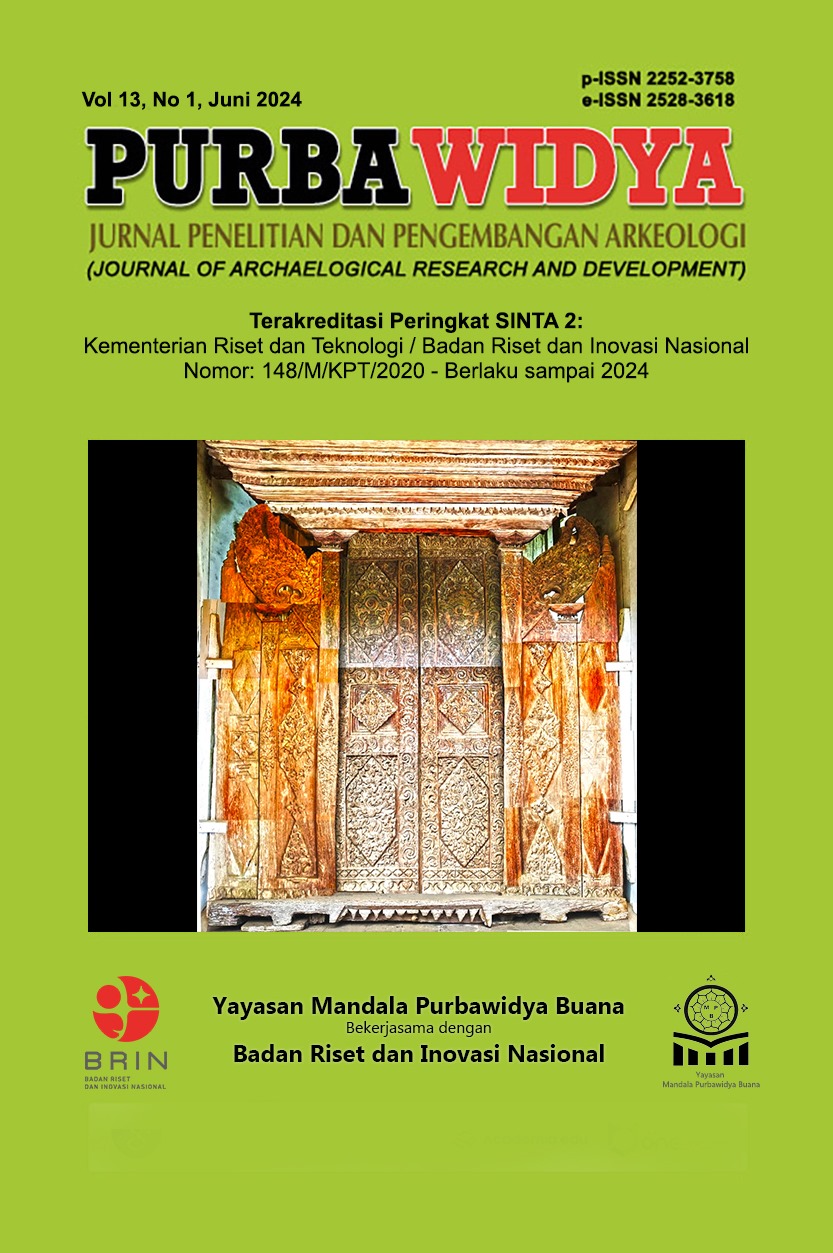Penelusuran sisa-sisa Kerajaan yang hilang dibalik Letusan Gunung Tambora di Situs Doro Bente
Main Article Content
Abstract
The archaeological research in the Tambora Peninsula was initiated by the National Archaeological Research Center in 2006, and from 2008 onwards, it was continued by the Archaeological Office in Denpasar-Bali until 2021. Numerous archaeological pieces of evidence have been successfully excavated from Mount Tambora's pyroclastic material. Recent research has been focused on the Doro Bente Site on the Teluk Saleh Peninsula. The research aims to understand the sequence of historical events on settlement centers based on artifact evidence resulting from the eruption of Mount Tambora in 1815. The study employs qualitative, descriptive methods, and a geoarchaeological approach. Data acquisition involves excavation, surveys, and literature studies. Stratigraphic analysis is conducted to identify sediment matrices and understand the deposition sequence. Excavation activities have uncovered significant artifacts such as ceramic fragments, pottery, animal bones, and shell fragments. Micro-scale deposition chronology in excavation box B28U18 indicates that the three lower layers, the oldest, were deposited in a marine environment, followed by five layers of pyroclastic material from the 1815 eruption of Mount Tambora. The geographical factors and available natural resources make Sumbawa Island a focal point for Chinese and European attention from the 13th to the 19th centuries AD.
Article Details

This work is licensed under a Creative Commons Attribution-NonCommercial-ShareAlike 4.0 International License.
Authors who publish with this journal agree to the following terms:
- Authors retain copyright and grant the journal right of first publication with the work simultaneously licensed under Creative Commons Attribution-NonCommercial-ShareAlike 4.0 International License that allows others to share the work with an acknowledgement of the work's authorship and initial publication in this journal.
- Authors are able to enter into separate, additional contractual arrangements for the non-exclusive distribution of the journal's published version of the work (e.g., post it to an institutional repository or publish it in a book), with an acknowledgment of its initial publication in this journal.
- Authors are permitted and encouraged to post their work online (e.g., in institutional repositories or on their website) prior to and during the submission process, as it can lead to productive exchanges, as well as earlier and greater citation of published work (See The Effect of Open Access).
References
Anggraita, Pramudita, and Wisjachudin Faisal. 2012. “Simulasi Aplikasi Siklotron Untuk Pertanggalan Radiokarbon (14C).” In Prosiding Pertemuan Dan Presentasi Ilmiah Teknologi Akselerator Dan Aplikasinya, 14:16–21.
Ardhana, I Ketut. 2005. Penataan Nusa Tenggara Pada Masa Kolonial 1915-1950. 1st ed. Jakarta: Raja Grafindo Perkasa.
Ashmore, Wendy, and Robert J. Sharer. 2010. Discovering Our Past A Brief Introduction to Archaeology. 5th ed. New York: McGraw-Hill Companies.
Chiesa, Ben, and Florian Knothe. 2017. Objectifying China Ming and Qing Ceramics and Their Stylistic Influence Abroad. Hongkong: University Museum and Art Gallery The University of Hongkong.
Geria, I Made. 2010. “Peradaban Tambora Dalam Perspektif Ekologi.” Forum Arkeologi 23 (1): 83–107. http://dx.doi.org/10.24832/fa.v23i1.216.
Hagerdal, Hans. 2017. Held’s History of Sumbawa. Amsterdam: Amsterdam University Press.
Haribuana, I Putu Yuda. 2013. “Jejak Permukiman Di Situs Tambora Dan Sekitarnya: Perspektif Geomorfologi.” Forum Arkeologi 26 (2): 125–34. http://dx.doi.org/10.24832/fa.v26i2.38.
———. 2017. “Situs Doro Bente Pada Bekas Kerucut Sinder Peti-Tabeh: Koridor Baru Penelusuran Jejak Kerajaan Yang Hilang.” Forum Arkeologi 30 (1): 11–20. http://dx.doi.org/10.24832/fa.v30i1.115.
Haribuana, I Putu Yuda, I Wayan Sumerata, and Ida Ayu Gede Megasuari Indria. 2020. “Jejak-Jejak Peradaban Tambora: Sebaran Temuan Arkeologi Terkait Aktivitas Kemaritiman Di Kawasan Gunung Tambora Dan Sekitarnya.” Badan Penelitian dan Pengembangan Pusat Penelitian Arkeologi Nasinal Kementerian Pendidikan dan Kebudayaan.
Haribuana, I Putu Yuda, I Nyoman Sunarya, I Nyoman Rema, I Wayan Sumerata, and Hedwi Prihatmoko. 2017. “Penelitian Situs Doro Bente Desa Sori Tatanga, Kecamatan Pekat, Kabupaten Dompu, Nusa Tenggara Barat.” Denpasar: Balai Arkeologi Bali.
Haribuana, I Putu Yuda, I Nyoman Sunarya, Luh Suwita Utami, Ni Putu Eka Juliawati, and I Wayan Sumerata. 2018. “Jejak-Jejak Peradaban Tambora: Ekskavasi Dan Survei Di Situs Doro Bente, Desa Sori Tatanga, Kecamatan Pekat, Kabupaten Dompu-NTB.” Denpasar: Badan Penelitian dan Pengembangan Pusat Penelitian Arkeologi Nasinal Kementerian Pendidikan dan Kebudayaan.
Haribuana, I Putu Yuda, and Jarwo Susetyo Edy Yuwono. 2018. “Jejak Permukiman Pada Bekas Kawah Doro Bente: Sebuah Perspektif Geoarkeologi Kawasan Tambora.” Forum Arkeologi 31 (2): 93–104. http://dx.doi.org/10.24832/fa.v31i2.542.
Juliawati, Ni Putu Eka, Rochtri. A Bawono, Luh Suwita Utami, Abu Muslim, and Aldhi W Pratama. 2021. “Doro Mpana: Situs Kubur Dari Abad Ke-13-14 Masehi.” Forum Arkeologi 34 (1): 15–24. http://dx.doi.org/10.24832/fa.v34i1.684.
Kartadinata, M.N., A.R Mulyana, E Kriswati, and N Haerani. 2008. “Peta Geologi Gunungapi Tambora Sumbawa, Provinsi Nusa Tenggara Barat.” Bandung: Pusat Vulkanologi dan Mitigasi Bencana Geologi.
Logan, J.R. 1986. The Journal of The Indian Archipelago and Eastern Asia. Vol. 1.
Parsons, Jeffrey R. 1972. “Archaeological Settlement Patterns.” Annual Review of Anthropology, no. 1: 50–127.
Prijono, Agus. n.d. Tambora Membaca Masa Silam, Menatap Masa Depan. Dompu-NTB: Balai Taman Nasional Tambora.
Purnawibowo, Stanov. 2018. “Kota Cina Dan Pulau Kompei: Perbandingan Temuan Arkeologis Aktivitas Perdagangan Di Bandar- Bandar Pesisir Timur Sumatera.” Berkala Arkeologi Sangkhakala 20 (10): 77–85. https://doi.org/10.24832/bas.v10i20.260.
Rema, Nyoman, and Syafrudin. 2019. “Pendekatan Ekologi Dalam Permukiman Kuno Situs Doro Manto.” Forum Arkeologi 1 (32): 24–38.
Sutawijaya, Igan Supriatman, and Haraldur Sigurdsson. 2006. “Characterization of Volcanic Deposits and Geoarchaeological Studies from the 1815 Eruption of Tambora Volcano.” Jurnal Geologi Indonesia 1 (1): 49–57.

